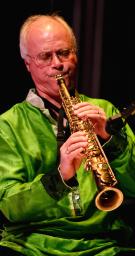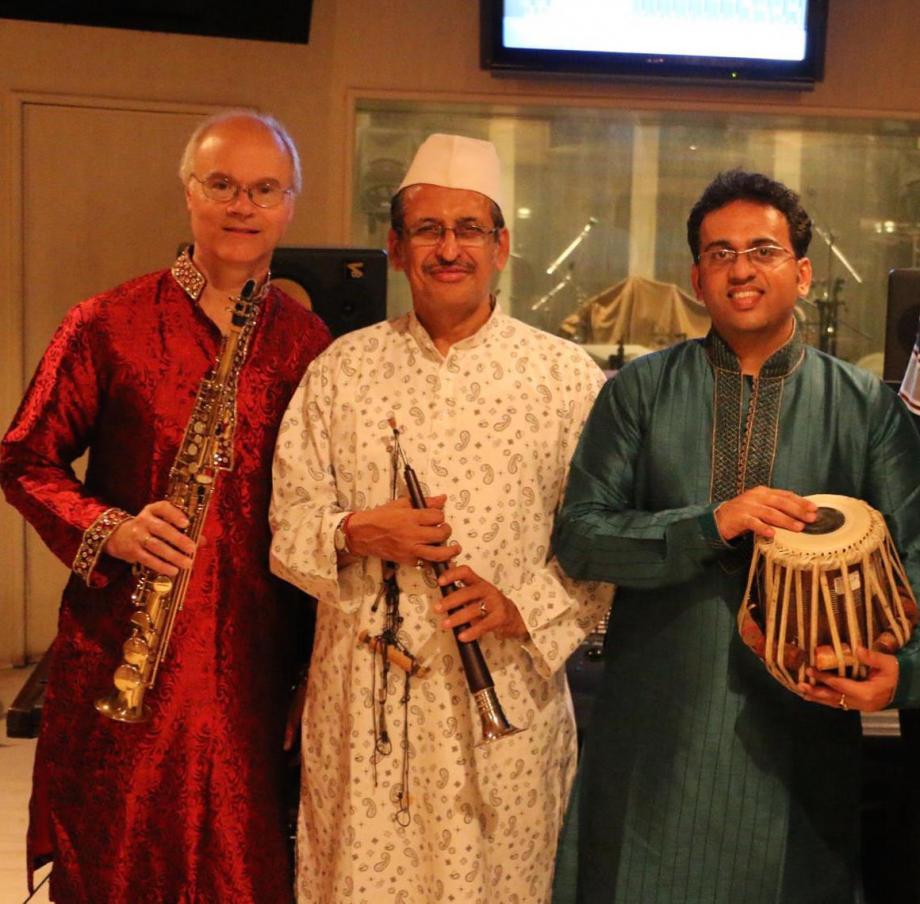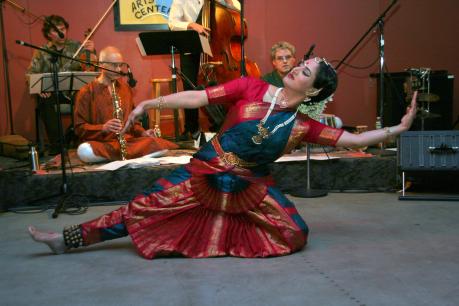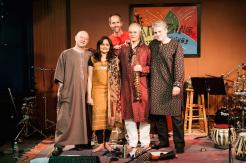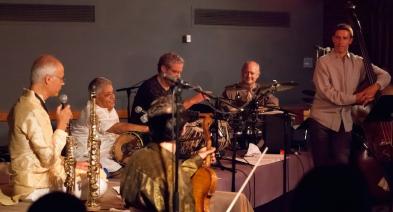Pioneering the Practice and Performance of Hindustani Music on the Saxophone - Interview with Master Saxophonist Phil Scarff
The Boston based popular and versatile musician Phil Scarff has been playing Indian classical music on the soprano saxophone for several years and has performed widely in the US and India. He has produced, recorded and published several compact disc (CD) recordings. Scarff’s latest CD release titled “Ragas on Saxophone†is a live concert recording from January, 2015 performed at the Hirai Sangeet Mahotsav in Chandrapur, India. The tabla virtuoso Bhushan Parchure, groomed by the tabla legends Ustad Alla Rakha and his son Ustad Zakir Hussain provided excellent accompaniment on the tabla. The CD features traditional as well as original compositions in ragas Puriya Dhanashri, Yaman and Rageshri, a famous devotional composition (abhang) “Mogara Phulala†with lyrics by Sant Dnyaneshwar and music by Pandit Hridayanath Mangeshkar and ends with a sprightly folk “Kajri†melody that creates the mood of joyful celebration at the onset of monsoon rains.
In the pursuit of Hindustani music, Scarff shares that he felt drawn to the shehnai instrument and particularly to the music of the shehnai-icon, the late Ustad Bismillah Khan. “The soprano saxophone has a lot in common with the shehnai – both are reed instruments with similar range, and they share some tonal qualities and techniques.†Scarff has performed with the well-known shehnai artist Shailesh Bhagwat several times, has collaborated with local Karnatik musicians and classical dancers and also leads the acclaimed world-jazz ensembles Natraj (which this reporter has had the pleasure and privilege of collaborating with) as well as the Lewis Porter-Phil Scarff group.
Scarff talks about his musical journey with Shuchita Rao of Lokvani.
Q. When did you develop interest in playing the Saxophone? Can you tell us about your teachers?
Phil: I grew up in Reading, PA, and started playing clarinet in fourth grade. At the recommendation of my band director, Al Leader, I added tenor saxophone in fifth grade. I started playing soprano saxophone in college and graduate school on borrowed school instruments. After graduation and starting to work, my first major purchase was the soprano saxophone that I am still playing to this day. Throughout my school years, I studied with Forrest Wise. In high school I studied clarinet for a year or two with Henry Duckham as well as jazz improvisation with pianist Ralph Tragle. In college I studied clarinet for one or two years with Allison Herz and also studied jazz improvisation with guitarist Joe Federico of Philadelphia. After moving to Boston, in 1980, I started studying saxophone and jazz improvisation with Jerry Bergonzi, and continued through 1985. I also studied with drummer Bob Gullotti for about a year in the 1980's to work on time and rhythm.
Q. What attracted you to Indian music?
Phil: The focus of jazz is improvisation. As a jazz musician I have always been interested in different approaches to improvising. Soon after moving to Boston, I met Warren Senders, who introduced me to some concepts based on raga improvisation, which I found very interesting and challenging. My decision to formally study Hindustani music was inspired by a collaboration with bansuri artist Steve Gorn in the mid 1980's.
Q. What age did your formal study of Indian music begin? Who was your Guru?
Phil: I started formal study of Hindustani Sangeet at age 28 with vocalist Kalpana Mazumdar in Boston. The next year I started my study trips to Pune, India, which continued over the course of about 13 years. There I studied with sundri maestro Pt. Suryakant Khaladkar, vocalist Pt. Shreeram Devasthali, and shehnai master Pt. Shyamrao Lonkar. In between trips to India I studied in Boston with sitarist Peter Row. Over the past 15 years or so I have been continuing my studies in Boston with vocalist Warren Senders.
Q. What difficulties if any, have you encountered in the learning process?
Phil: Understanding musical concepts that do not have exact analogies in Western music was a challenge. Getting used to playing with a drone and adjusting from even-tempered Western tuning to Indian tuning was another hurdle. For example, the shuddha Ga is quite a bit lower in Hindustani music compared to the even-tempered scale. Getting comfortable with hearing the rhythmic cycle as played on tabla, rather than hearing harmonic progressions also took some effort. Some of the biggest challenges were adapting the nuances of Hindustani Sangeet, especially meend, to saxophone.
Q. What important experiences shaped your desire to continue learning and performing Indian music on the saxophone?
Phil: I knew from the outset that saxophone is my instrument, at least in this lifetime, and therefore I would learn to play Hindustani music on saxophone, rather than learning an Indian instrument. Initially, I planned to study Hindustani Sangeet for about 3 to 6 months and then move on to other things. But the more I learned, the more I realized the depth and power of the music, and that 3 to 6 months is still going on.
Q. Which artists do you like to listen to in Indian Classical music?
Phil: My primary model for playing Hindustani music on saxophone is shehnai. My favorite artists are Bismillah Khan and also Ali Ahmed Hussein. I draw on bansuri as well, and listen to artists such as Hariprasad Chaurasia and Ronu Majumdar. I listen to Kadri Gopalnath's adaptation of Karnatak music to saxophone. I also listen to vocalists including Mallikarjan Mansur, Ajoy Chakrabarty, Amir Khan, Bhimsen Joshi, Gundecha Brothers, Parween Sultana, Kishori Amonkar, Sruti Sadolikar, and Veena Sahasrabuddhe, to name a few.
Q. Indian music relies heavily on the use of microtones in raga development. Do you feel that the Saxophone as an instrument is well suited to emulate this quality of Indian music?
Phil: There is no doubt that it is a challenging adaptation, with meend being the most difficult. Gamak is easier to manage. After my recent immersion workshop with the Gundecha Brothers, I have also been incorporating much more subtle microtonal inflections as well.
Q. Indian Bollywood music has used the saxophone instrument in orchestration. Do you know and play Hindi film songs that have saxophone interludes? Could you mention any favorites?
Phil: My focus is primarily in the classical realm and I have not spent much time on Bollywood music. However, I have played a few pieces, such as "Mere Naina Sawan Bhadon."
Q. What has the experience of collaborating with Indian dancers and musicians been like? Which collaborations have been most memorable and why?
Phil: I have collaborated with quite a few Hindustani and Karnatak musicians, as well as Bharatha Natyam and Kathak dancers, in both classical and fusion performances. The most memorable collaborations are the ones that felt quite natural and intuitive. When dance is involved, one challenge is getting used working with visual cues from the dance, in addition to the more usual musical cues from other musicians.
Q. You also are interested in West African music. When and how did you get interested in the music of that region?
Phil: I became interested in West African music, starting with the music of the Ewe group from southern Ghana and Togo, in the early 1980's. A collaboration with David Locke and the Agbekor Drum and Dance Society sparked my interest in studying this music and its complex polyrhythms. After forming Natraj, we collaborated with Agbekor many times over the years, and I have had opportunities to study with visiting master drummers as well. We later studied Dagomba music from northern Ghana, and more recently Natraj has been performing with Lamine Toure and learning music from Senegal.
Q. You have produced several CD albums. What inspired and motivated you to produce this newest CD album?
Phil: This was the last appearance of a nine-concert tour of India, and tabla artist Bhushan Parchure performed on all but one of these, so our collective musical intuition was at a peak. I found the audience at Hirai Sangeet Mahotsav to be very enthusiastic, which inspired our performance on stage. We managed to capture a very high quality recording of this program as well, so it naturally made sense to release it on this CD.
Q. You have visited and performed in India. Can you describe your experience of performing for Indian audiences? Are you currently planning another performance tour in India?
Phil: I have been touring India performing Hindustani concerts annually for about the last 10 years. I just returned from my latest tour, which included eight concerts in Jaipur, Belgaum, Hyderabad, Goa, and Bengaluru. On this tour I played three jugalbandi concerts, each with a different with first time collaborator. I have generally found audiences in India to be discerning, supportive, and enthusiastic, which encourages me to continue. I am targeting Winter 2019 for my next tour, but I have not yet started the planning, process.
Q. I understand that you are a poet in addition to being a musician. Could you share one of your poems with our readers?
Phil: Here is a poem I wrote in December, 2017 titled “Inside out and Outside inâ€
Jazz and Hindustani Sangeet
Both improvisational
Both inspirational
Each comes from the heart but touches the soul
Powerful and deep
Reaching for the sky
One informs the other and the other informs the one
What's the difference?
It's all music
You can fuse them together or play them separately, but you can't keep them apart
The form and grammar may be different, but they speak the same language
Meditative
Playful
Energetic
Rhythmic
Interactive
In the moment
Both improvisational
Both inspirational
What's the difference?
It's all music
Jazz and Hindustani Sangeet
